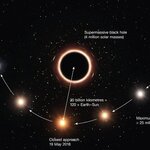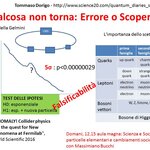On September 4 to 8 the city of Mantova, in northern Italy, will be brimming with writers and readers. The event is called "Festivaletteratura" and brings together authors and consumers of books of all kinds, in a week-long kermesse with interviews, debates, public lectures, and the like. Just as six years ago, when the Higgs boson discovery was hot off the press and everybody wanted to hear the details, I have been invited there to hold two public lectures. The first will be held in the Aula Magna of the university, and its title will be "Science and Society 2.0: Elementary Particles…
Physics

Version 2 of a thick textbook on particle and astroparticle physics is out, and you should have a look at it (well, at least if you're seriously interested in the topic!). The book, titled "Introduction to Particle and Astroparticle Physics" (not a very imaginative title, admittedly, but at least a faithful one) has a more descriptive subtitle: "Multimessenger Astronomy and its Particle Physics Foundations". It is authored by Alessandro de Angelis and Mario Pimenta, two acknowledged experts of the field. The previous version of the book, dated 2015, was very successful, so the editor (…

Do you know the works of Tim Blais, the guy behind "A Capella Science"? I sincerely hope you do, but otherwise this post is for you. Tim has a youtube page where he publishes his amazing works.
Tim sings modified lyrics of famous songs, and mixes them with multiple tracks of his own voice imitating each of the instruments of the underlying orchestra, or other choral voices. Until here you could well say there's nothing new under the Sun, except that Tim has been capable, through amazing mixing and editing skills as well as awesome vocal gift, of producing quite entertaining videos. But…

The effects predicted by Einstein’s general relativity on the motion of a star passing through the extreme gravitational field have been validated near the supermassive black hole in the center of the Milky Way.Obscured by thick clouds of absorbing dust, the closest supermassive black hole to the Earth lies 26 000 light-years away at the centre of the Milky Way. This gravitational monster, which has a mass four million times that of the Sun, is surrounded by a small group of stars orbiting around it at high speed. This extreme environment — the strongest gravitational field in our galaxy —…

[Eleni Petrakou, Ph.D., is a physicist and an independent researcher, besides being a longtime follower of this blog. She now has a newsletter of her own; it is high S/N stuff - check it out here. After a past collaboration with the CMS experiment, she has recently become intrigued with the dynamics of the Sun, and she developed a model to try and predict the solar cycle, a 11-year variation of the activity of sunspots and solar flares whose origin is still debated. I asked her to describe the matter for this blog, and the text below is the result - TD]
DESCRIBING THE SOLAR CYCLE
No matter…

Everyone knows that water is a molecule in which a single oxygen atom is linked to two hydrogen atoms - H20.
But the story of water gets a lot more scientifically interesting the deeper you go. Water actually exists in two different forms, called isomers, at the molecular level.
They have almost identical physical properties, you can't tell the difference, but chemists can tell them apart by the relative orientation of the nuclear spins of the two hydrogen atoms. They are called ortho- or para-water depending on whether the spins are aligned in the same or opposite…

If you want to know how to do time travel, ask a mathematician. If you want to show how math is not science, but is instead the language of science, hand those equations to a physicist.
That is the challenge proponents of a new type of "dibaryon" - a particle that contains six quarks instead of the usual three - face. They have done simulations of quantum chromodynamics (QCD) but now they want to hand that off to physicists and expect them to go hunting for it.
"Baryons", principally protons and neutrons, are particles composed of three quarks bound tightly together, with their…

What is spectroscopy ? (A) the observation of ghosts by infrared visors or other optical devices(B) the study of excited states of matter through observation of energy emissions
If you answered (A), you are probably using a lousy internet search engine; and btw, you are rather dumb. Ghosts do not exist.
Otherwise you are welcome to read on. We are, in fact, about to discuss a cutting-edge spectroscopy measurement, performed by the CMS experiment using lots of proton-proton collisions by the CERN Large Hadron Collider (LHC).
Indeed, the data used are a lot: 80 inverse…

The ICHEP conference opened today in Seoul. This is the most well-attended conference in particle physics around, with usually over 1000 participants. The week-long event dictates the deadline of particle physics and astrophysics experiments around, as every collaboration wants to show updated results of their searches and measurements in that venue, to have a share of the spotlights. This means that you can bet the month of June was a hectic one for ATLAS and CMS collaborators alike (but also those of LHCb and ALICE, just to mention the main four CERN endeavours).
In practice it…

Happy Birthday Higgs boson! The discovery of the last fundamental particle of the Standard Model was announced exactly 6 years ago at CERN (well, plus one day, since I decided to postpone to July 5 the publication of this post...).
In the Standard Model, the theory of fundamental interactions among elementary particles which enshrines our current understanding of the subnuclear world, particles that constitute matter are fermionic: they have a haif-integer value of a quantity we call spin; and particles that mediate interactions between those fermions, keeping them together and…
